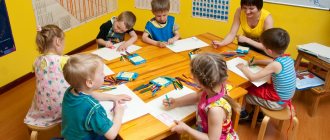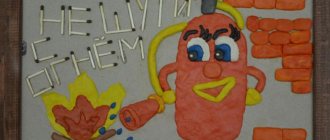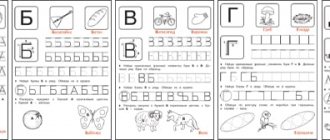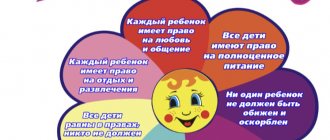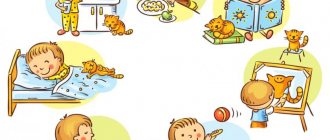The desire of parents for their child to be able to write letters and numbers beautifully is understandable and justified. But desire alone is not enough. A lot of effort and patience should be put in so that your beloved child can easily complete the tasks in the copybooks. And therefore, caring parents are advised to follow those rules that help. Below in the article you will find copybooks for preschoolers, which you can download to your computer and print. We recommend that you first read the rules for teaching your child to write in the copybooks so that you can initially position your hand, tilt, and posture correctly.
All files are checked for viruses using the virustotal service.
Recipes for downloading
| Bortnikova E. “My first copybooks. Cells and rulers" | Medeeva I. G. “Copybooks for preschoolers. We write using rulers" | Petrova E. S. “Copybooks with exercises for kids” |
| Zakharova O. “Copybooks for preschoolers. We write and pronounce correctly" | Alexandrova O. “I want copybooks for school. Learning to write. For preschoolers" | Zakharova O. “Copybooks for preschoolers. We read syllables and write |
| Copybook coloring pages for preschoolers, colorless | Operenova O. V. “I write words. Workbook for children 4 - 6 years old" | Copybook coloring pages for preschoolers, colorless |
| Shtets A. A. “Propis. Textbook for 1st grade" | Zavyazkin O. “Template copybook for the Russian language” | Betenkova N. M. “Prescription for preschoolers. My first notebooks" |
| Bezrukikh M. M. “Copybooks for first-graders with difficulties in learning to write and left-handed children” | Panshina I. A. “Copybook for left-handers” | Gavrina S. E. and others “Draw by cells. Notebook No. 2 with tasks for children's development" |
| Shevchuk L.N. “Getting ready for school. Copybooks for preschoolers in a line for children 4 - 6 years old" | Bortnikova E. F. “My first copybooks. Notebook for children 5 - 6 years old" | Bortnikova E. F. “My first copybooks. Notebook for children 6 - 7 years old" |
| Fun copybooks for preschoolers | Golenishcheva O. “Copybooks. Charging for fingers" | “Copybooks for preschoolers. We draw with both hands. For children 5 - 6 years old" |
Now there is such a variety of developmental notebooks, aids for preparing for school... This collection contains good copybooks for those who are just learning to write letters and those who have to hone their skills.
There are four golden rules for working with your child in the selection of math workbooks. In the case of copybooks, you can only add that the child’s hand may get tired out of habit. Please be understanding about this.
Here are game and classic variants of copybooks. One is not always better than the other. Read the annotations carefully, flip through the pages, choose what you like. So that you and your child like it.
Easy and fun activities for you!
Soboleva O.L., Agafonov V.V., Agafonova O.V. “Space copybooks for schoolchildren and first graders”
These copybooks are for games. The child, together with the Scientist Cat, goes on a space journey from one letter planet to another.
Each page is an on-board computer screen. At the beginning of the book they warn that the outline of each letter is the flight path of the spacecraft, and the success of the flight depends on the efforts and diligence of the pilot (child).
Copybooks teach you how to write, copy, read written text, and even create it yourself. And also – which is important – at the beginning of getting acquainted with each letter, its correct spelling (with arrows) and letter connections are shown.
T. Larina “Copybooks for 1st grade with riddles”
Recipes according to the Federal State Educational Standard, format slightly larger than A4. On each page there is a riddle for a specific letter, the spelling of which will be practiced.
To develop fine motor skills, coloring of contour illustrations is provided.
At the top of the page, arrows show the correct spelling of a letter. These copybooks are a budget option for practicing writing skills.
M. Reitses “Letter machines and squiggles”
Another option for game recipes. Here you can get behind the wheel of a truck, steal a fire truck, or take a plane into the sky, and straight lines and perseverance will help you do this. However, in gaming techniques the latter somehow appears on its own.
Task options:
“Moving on the ground is boring! Launch your boat into the open sea!" (task on wavy lines)
“Feel like a navigator! Quickly but legibly draw arrows in accordance with the direction of movement.”
At the end of the notebook is a diploma in driving fantastic vehicles.
N.S. Zhukova “Recipes”
N.S. Zhukova is a famous speech therapist, candidate of pedagogical sciences. She has written many manuals on speech development, a primer, and copybooks.
Teaching preschoolers to write is based on the syllabic principle of Russian graphics. A syllable acts as a unit of writing in which the writing (and reading!) of vowel and consonant letters are interdependent and represent an integral graphic element. The copybooks contain notes from the author about how best to work with a child.
Tatyana Shklyarova “Copybooks. Let's learn to write beautifully and competently. Allowance for children 5-7 years old"
0
Lesson copybooks give the child the opportunity to master writing and even study sound-letter analysis.
The book contains explanations for the lessons - what we reinforce in each specific lesson, what we explain new (sometimes literally verbatim, what to say to the child), what to pay attention to, what examples to give. The pages for parents are written in an accessible and clear manner, without abstruse words. Attention! T. Shklyarova also has recipes for left-handers.
M. Reitses “Princess's copybooks”
Game copybooks for little princesses - mi-mi-mi, frills, roses and other delights. And what cute drawings there are!...
Princesses put signatures on decrees of execution and pardon. They draw up invitations to balls and send letters to princes in scented envelopes. But here’s the problem – for this you need to be able to write! No problem, with this book your princess will learn in no time. 7. M. Reitses “Crazy copybooks”
Here all the tasks - shading, tracing, painting - are built around weirdos. These are such unusual characters that every spread is dedicated to, and the children will have to get to know them better, and sometimes help them.
Tatyana Belenkaya “Copybooks for preschool children. Seasons."
Option for budget statements. With their help, the child studies the same type of elements into which the letters of the Russian alphabet are divided. Each element is introduced using simple images: a flower, a bee, a bow, a fish...
The notebook is divided into 4 thematic parts: autumn, winter, spring, summer. Questions and short assignments will help you study and understand the topic.
Svetlana Voskresenskaya “In the land of simple hooks”
Colored copybook simulators for preparing your hand for writing.
There are not only the usual sticks and hooks, but also animals, birds, objects that need to be colored and traced.
On each spread, parents will find step-by-step instructions that will help explain to their child how to correctly draw the elements of letters, as well as additional tasks.
Recommended age: 5-6 years.
S. Voskresenskaya also has a notebook for older children - “In the Land of Complex Squiggles”
Svetlana Gavrina “Learning to write. Workbook for children 6-7 years old"
A guide for preparing for school - there are tasks for shading, for tracing a picture along dotted lines, for practicing writing elements of letters, etc.
The notebook provides material according to the principle of increasing complexity - from simple to complex.
“Transparent copybooks. Sticks and hooks" (Phoenix publishing house, 2017. Series "Educational copybooks")
The main feature of these copybooks is transparent pages with thick but transparent paper, which are superimposed on sheets with written letters. The child can only circle what is written. A good additional guide for mastering the skills of writing letters.
Vera Ilyukhina “Miracle copybook. For 1st grade of primary school. In 4 parts"
Sound-letter analysis, shading, classic hooks and sticks leading to the writing of letters, words and sentences.
Copybooks according to the Federal State Educational Standard, the Russian School program.
Uzorova O.V., Nefedova E.A. “Quick preparation for school”
A budget version of the workbook for general development and preparation for school. The material is divided into weeks. Each spread contains initial information about mathematics, the world around us (page on the left) and practical exercises in copybooks (page on the right).
Black and white pages, regular student notebook format.
Tatiana Voronina “ABC. 1 class. Copybook for the textbook by V. G. Goretsky and others. In 4 parts"
Page by page, the child masters the skill of writing letters. First, shading and finishing, then writing words, letters and sentences. Much attention is paid to the sound-letter analysis of the word.
Colored pages. The recipes comply with the Federal State Educational Standard.
And further. Pay attention to sites - online generators of copybooks. You specify the text, then it can be downloaded in the form of lined copybook. All you have to do is print it out and give it to your child.
There are many such sites now, use the search and choose the one you like best.
Creating conditions for classes in copybooks for preschoolers
The primary task is to organize the baby’s workplace. The child must understand that the play area is incompatible with the learning areas. Therefore, you should carefully consider and determine a comfortable space for practicing copybooks, taking into account the following factors:
Installation of necessary equipment
Let's consider the question of choosing a desk and a chair for it. The parameters directly depend on the baby’s growth. We can safely say that furniture for a child grows with him. The chair on which the future student will sit should not be too high for his feet. When the child sits on the high chair, the feet are comfortably placed on the floor. We also choose a student’s desk based on height, but at the same time taking into account the parameters of the selected chair. The length of the desk is at least 600 millimeters and the width is no more than 50 centimeters. In this case, choose the color of the student desk in a neutral shade. The color should not be too dark or light.
Selection of lighting equipment for a preschooler
A necessary parameter for child visual hygiene. The main criteria when choosing table lighting are:
- Uniform luminous flux.
- No discomfort from too bright light.
- Subtle color and graphic design of the lampshade.
- The lamp should completely hide the light bulb and be shaped like a trapezoid or a small cone.
- It is desirable that the color of the lamp, which is necessary for better visual perception, matches the green tint. This color is favorable for the pupils of the eyes.
Please observe these criteria for the necessary arrangement of a child’s writing area when purchasing. A properly equipped workplace for a future student is a kind of foundation for future achievements.
Preparing a preschooler for practical exercises with copybooks
Having placed the equipment and inventory properly, take care of equally global tasks that are also necessary to achieve your goals. For example, such as:
Gradual adaptation of the child to the desktop. Teach your future student to take a break from games and engage in practical work. Do this systematically and little by little. During such abstractions from games, take up drawing or modeling with your child. The main basis here is the child’s getting used to working at a desk. The best option for adapting to such activities would be daily and at a certain time.
Correct posture at the student desk
To avoid subsequent complications of the spinal muscles and spine, as well as malfunction of internal organs, you should strictly follow the rules for the prevention of poor posture. Since it does not help in preventing curvature in the spinal part and has a beneficial effect on mental performance and the development of attentiveness. Therefore, it is imperative to teach your child to sit correctly at a desk. Below are the basic rules for sitting at a study table:
- The knee part has a strict right angle.
- The elbow joints lie on the student's table.
- The feet of both feet are on the floor. If your feet do not reach the floor surface, you should purchase a special footrest.
- The back is kept straight and not tense. A special protrusion on the back of the chair provides invaluable assistance. It is necessary as support for the lumbar part.
- During classes, make sure that the child does not tilt his head forward or try to bend his back to the side.
Choosing a pen for writing copybooks
This task is not as easy as it might seem initially. Today, the stationery market is extensive and the range of pens is correspondingly rich. To choose the right option for your beloved child, you will have to understand the intricacies of the product you are purchasing.
- The plastic pen tube must have a writing ball tip.
- The ink is pasty and of good quality.
- The handle body has no ribbed surface.
- For left-handers, there are handles with a special angle.
- The rod is required without scratching the paper indicators.
- The length of the writing instrument is medium-sized (about fifteen centimeters).
- Under no circumstances should you use a pen with gel filler, as its use will inevitably lead to a negative calligraphy result.
After the child has become accustomed to systematic studies and has learned to hold his back at the desk, we can say that he is ready to master copybooks.
Rules for alphabetic and numeric spelling in copybook for preschoolers
The next stage is to perform immediate tasks regarding the correct writing of numbers and letters in copybooks. To help your child achieve results, pay attention to:
- Correct hand position while writing. A right-handed child must remember that the tip of the pen with which he writes points to the shoulder of his right hand. Well, naturally, the mirror image of this rule is the left shoulder for left-handed people.
- Any writing utensil, be it a pen or a pencil, must be grasped with three fingers. On top is the index and thumb, and on the bottom is the middle.
- The distance from the rod tip to the index finger is 15 millimeters. Try not to forget about this little detail, otherwise the future student will get used to writing in a way that is convenient for him at that time.
- When writing, you should not forget about the gap between the desk and the abdominal part of the body; the size of this distance is one fist length.
- The distance between the eyes and the working base of the table is 30 centimeters, otherwise the child will have vision problems.
- The copy sheets required to be filled out are rotated 30 degrees away from you for better perception of information.
- The hand pressure on the writing instrument is average.
When writing alphabetic or numerical values in special notebooks, you should not forget that:
- The hand with which a child writes letters or numbers is directly connected to the wrist. This part of the brush is its direct support.
- When writing, make sure that the little finger and the edge of the writing hand move the wrist gradually and carefully.
- Use rubber tips on writing instruments. They have small grooves for the fingers. With its help, you can speed up the process of holding your hand correctly when writing.
For children who write with their left hand, there are slight deviations from the general rules and they say the following:
- In the process of writing numerical or alphabetic values, the pen and the writer's left hand are in one straight line.
- Unlike the generally accepted left position of the light source for right-handed people, in left-handed children it is located on the right side.
- The paper tilt parameter also changes. In this case it is approximately 20 degrees.
- The distance between the writing tip of the pen and the index finger is separated by 4 centimeters.
Regardless of which hand is more comfortable for a child to write with, one should not forget that exercises are the main help. Training to develop fine motor skills of the hands in preschool age will facilitate the perception of new sensations when writing. Since minor physical activity develops arm muscles.
Completing the above tasks will require time, perseverance, and patience. The main thing is a good mood. This indicator will create a favorable atmosphere for a child to learn to write.
